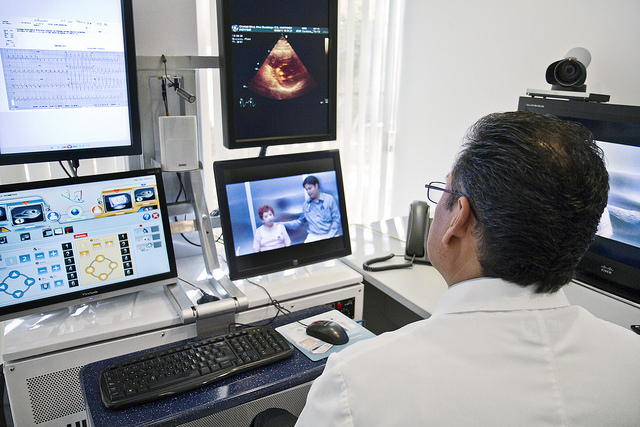News
Algorithmic MDs Will Ruin Healthcare, Nurses Say

In a bid to make healthcare cheaper and faster, hospitals are turning to algorithmic systems for diagnosing patients. But the national nurses' union says that robots-meet-super-WebMD are no replacement for a real doctor.
Algorithms that can analyze symptoms and spit out a diagnosis favor efficiency over proper care, according to a recent campaign by National Nurses United (NNU). The union claims that automated diagnosis systems lack the individualized care a nurse can provide and mainly allow private hospitals to boost their bottom line.
Healthcare professionals have worked for years to develop diagnostic algorithms—including early methods like Apache III and SAPS III, as well are more more advanced clinical decision support systems—which are used to help determine how patients are treated.
They compare patient symptoms to a base dataset—Apache III's was culled from over seventeen thousand ICU patients—to determine things like mortality probability and whether a patient should remain in intensive care or be moved. It may be a bit impersonal and morbid, but it’s efficient. Instead of improving the quality of healthcare, however, NNU sees these algorithms as eroding it.
“What this technology does is generate profits for healthcare corporations because they standardize based on this model of care that’s based on the factory floor. You treat everybody like a Model T Ford,” Deborah Burger, a registered nurse and co-president of NNU, told me over the phone.
By speeding up the provision of care with algorithms, private hospitals can serve more patients in a day—and charge them accordingly. Apache III collects patients’ information and sends it right to the hospital’s billing department. “It’s actually a billing mechanism more than it is a treatment protocol,” Burger said.
To be sure, that kind of efficiency is a boon to companies like the Hospital Corporation of America, who invests more than one billion dollars annually to keep its hospitals up to date technologically.
Some, like Harvard economist David Cutler, have argued that information technologies will eventually make healthcare more like Walmart. Decision-making algorithms would streamline the provision of care, he argues, and ultimately make it as impersonal, efficient, and cost effective as the retail market. This may one day be true, but efficiency often comes at a human cost, as well as a monetary one.
A 2010 study on methods of diagnosing urinary tract infections, published in Deutsches Ärzteblatt International, found that algorithmic diagnoses using a clinical dataset alone had an error rate of approximately thirty-three percent. A wrong diagnosis could have serious consequences if, for example, a patient is moved from the ICU when they really needed to be there. Ignoring a patient’s medical history when making important decisions could very well lead to such a situation, Burger argued.
“When you’re doing computer protocols and looking at these scatter charts, it leaves out all these other variables out there that can affect your outcome,” Burger said. “There’s certain averages as to what these patients will respond to, but what happens is each patient can react differently, and does.”
“You have to look at how much these gadgets cost, how much these personalized DNA treatments cost, and who can actually afford that."
Though diagnostic algorithms may be flawed now, technologies that individualize healthcare could improve them. Wearable tech like bracelets, hats, and shirts that monitor health-related data can measure everything from physical activity to the severity of sport-related impacts. Bringing that data to the doctor could make an algorithm like Apache III far more accurate. Personalized medicine tailored to an individual’s genome could also make treatment more effective. Burger agreed, but the real question, she said, is who can afford these technologies in the first place?
“You have to look at how much these gadgets cost, how much these personalized DNA treatments cost, and who can actually afford that,” Burger said. “You start tiering the medicine—the provision of healthcare—based on your ability to pay. It gets back into whether you have a platinum plan, gold, bronze, silver, or whether you have a paper plan; or no healthcare.”
Fitness trackers like the Misfit Shine and the Basis Band cost one hundred and two hundred dollars, respectively. It might not seem like much to the type of person liable to order one anyway, but one hundred bones can be a bundle when you can’t afford healthcare to begin with. As for medicine tailored to a person’s genome, the technology is still in development and we don’t really know how much it will cost. My hunch is that it won’t be cheap for a very long time.
Using algorithms to simply cut corners and treat people quicker is certainly cause for concern, but the technology itself isn’t necessarily to blame. (Robotic surgeons may be a different story.) Yes, algorithms have some issues in terms of how they measures statistical data to make specific diagnoses, but if integrated into a healthcare system that privileges proper care over efficiency, they could be helpful.
“We’d like to see it used as a resource, rather than a bible,” Burger said. “Also, not using it as a way of deciding who gets care, and who doesn’t get care—whether you decide to treat or to withdraw care. That should be left up to the family and the professionals who are providing care to that patient.”
Bugs in diagnostic algorithms and wearable health monitors can be fixed relatively easily, but the systemic problems that plague the private healthcare sector are quite different. Diagnostic algorithms have some issues, but it’s the healthcare system that’s truly broken—and that’s what we should be trying to fix.